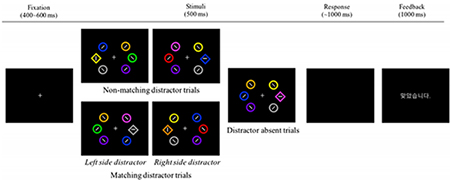
We investigate selective visual attention. What is the role of visual selective attention in face recognition? Is word recognition an automatic process? To answer these questions, we have conducted series of experiments which provided the following findings.
1) The Stroop dilution effect occurred when a color word was presented as a distracter but not when it was presented as a color carrier.
2) The magnitude of the Stroop effect decreased as display duration decreased.
3) A larger Stroop effect was obtained when the color word was presented at the attended location than when it was presented at an unattended location. The role of visual selective attention in various tasks is now being further examined.
Publications
Impaired cognitive control during reward pursuit and punishment avoidance
Choi and Cho. 2020. Motivation and Emotion.
The effects of induced and trait anxiety on the sequential modulation of emotional conflict
Jeong and Cho. 2020. Psychological Research.
Attentional orienting by non-informative cue is shaped via reinforcement learning
Cho and Cho. 2020. Frontiers in Psychology.
Cognitive control under high threat_The effect of shock on the congruency sequence effect
Jeong and Cho. 2019. Motivation and Emotion.
Memory facilitation for emotional faces_Visual working memory trade-offs resulting from attentional preference for emotional facial expressions
Lee and Cho. 2019. Memory & Cognition.
Uncertainty as a determinant of attentional control settings
Kim, Park and Cho. 2019. Attention, Perception, & Psychophysics.
Multiple attentional control settings on distinct locations without the confounding of repetition priming
Cho and Cho. 2018. Attention, Perception, & Psychophysics.
The cognitive loci of the display and task-relevant set size effects on distractor interference_Evidence from a dual-task paradigm
Park, Kim and Cho. 2018. Attention, Perception, & Psychophysics.
Prolonged interruption of cognitive control of conflict processing over human faces by task-irrelevant emotion expression
Kim et al. 2017. Frontiers in Psychology.
Memory-based attentional capture by colour and shape contents in visual working memory
Kim and Cho. 2016. Visual Congnition.
The modulating effect of emotional valence on the speed of involuntary attentional capture
Kim and Cho. 2016. The Korean J of Cog and Bio Psy.
Attention and memory bias to facial emotions underlying negative symptoms of schizophrenia
Jang et al. 2016. Cognitive Neuropsychiatry.
Control processes through the suppression of the automatic response activation triggered by task-irrelevant information in the Simon-type tasks
Kim, Lee and Cho. 2015. Acta psychologica.
Adjustment to subtle time constraints and power law learning in rapid serial visual presentation
Shin, Chang and Cho. 2015. Frontiers in Psychology.
Effect of abrupt onsets attentional capture by the color word in the Stroop task
Park and Cho. 2015. The Korean J of Cog and Bio Psy.
Attentional capture as an alternative view of perceptual load theory and early-visual crosstalk account
Suh and Cho. 2015. The Korean J of Cog and Bio Psy.
Congruency sequence effect without feature integration and contingency learning
Kim and Cho. 2014. Acta psychologica.
The Effect of the Chance of a Distractor Capturing Attention on Distractor Interference
Suh and Cho. 2013. The Korean J of Cog and Bio Psy.
Congruency sequence effect in cross-task context_Evidence for dimension-specific modulation
Lee and Cho. 2013. Acta psychologica.
Likelihood of attending to the color word modulates Stroop interference
Cho, Choi and Proctor. 2012. Attention, Perception, & Psychophysics.
Impaired color word processing at an unattended location_Evidence from the Stroop task combined with inhibition of return
Choi, Cho and Proctor. 2009. Memory & Cognition.
Influence of color word availability on the Stroop color-naming effect
Kim, Cho and Proctor. 2008. Perception & Psychophysics.
Computational Models of Visual Masking
Francis and Cho. 2006. The First Half Second (MIT press).
Stroop dilution depends on the nature of the color carrier but not its location
Cho, Lien and Proctor. 2006. J of Exp Psy Human Perception and Performance.
